All Management News
- Dr Vineeth Thomas August 1, 2022
- BSc Psychology students to pursue Masters in the UK, US universities August 1, 2022
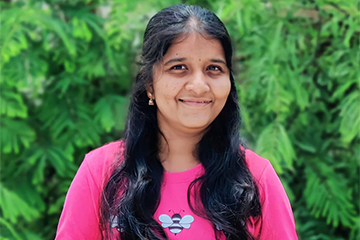 Sravani Govindu is proud to be a part of the first ever batch of Psychology from SRM University-AP. She is always amazed by the influence the faculty and friends had on her character development throughout the years. Sravani recollects how she was an unbothered soul without any focus before joining the university and what she became after experiencing the rhythm of the campus. During her university life, she recognised the value of having a sense of purpose. The continuous efforts from the faculty to provide the right amount of guidance and motivation will forever be a fuelling force in Sravani’s career. She is beyond grateful to the supportive academic community on the campus which became her backbone whenever she was uncertain. The value-oriented course structure at SRM AP encouraged her on many levels. Sravani adores the welcoming aura of the campus and the dynamics between students from various states and countries. She is ready to welcome a new chapter at Greenwich University while holding a bunch of memories from SRM AP.
Sravani Govindu is proud to be a part of the first ever batch of Psychology from SRM University-AP. She is always amazed by the influence the faculty and friends had on her character development throughout the years. Sravani recollects how she was an unbothered soul without any focus before joining the university and what she became after experiencing the rhythm of the campus. During her university life, she recognised the value of having a sense of purpose. The continuous efforts from the faculty to provide the right amount of guidance and motivation will forever be a fuelling force in Sravani’s career. She is beyond grateful to the supportive academic community on the campus which became her backbone whenever she was uncertain. The value-oriented course structure at SRM AP encouraged her on many levels. Sravani adores the welcoming aura of the campus and the dynamics between students from various states and countries. She is ready to welcome a new chapter at Greenwich University while holding a bunch of memories from SRM AP. Meenu Roy is proud to be an SRMite and belongs to the first batch of Psychology at the University. She is in awe of the momentum her personality growth acquired from the eventful campus life. Clubs and other university activities helped her try things beyond her expectations. She enjoyed the whole process of exploring herself throughout the academic venture at SRM University-AP. She finds it fortunate to have a supportive academic ecosystem at her crucial career junction. Meenu is about to pursue her master’s degree from the University of Westminster, UK. Her admiration towards the faculty and friends she had at SRM AP grows further as she continues to go places and prove herself. A part of the campus life and wisdom she enjoyed at the university will stay with her for a lifetime while she keeps on adding value to the recognition of SRM University-AP with her academic intelligence.
Meenu Roy is proud to be an SRMite and belongs to the first batch of Psychology at the University. She is in awe of the momentum her personality growth acquired from the eventful campus life. Clubs and other university activities helped her try things beyond her expectations. She enjoyed the whole process of exploring herself throughout the academic venture at SRM University-AP. She finds it fortunate to have a supportive academic ecosystem at her crucial career junction. Meenu is about to pursue her master’s degree from the University of Westminster, UK. Her admiration towards the faculty and friends she had at SRM AP grows further as she continues to go places and prove herself. A part of the campus life and wisdom she enjoyed at the university will stay with her for a lifetime while she keeps on adding value to the recognition of SRM University-AP with her academic intelligence.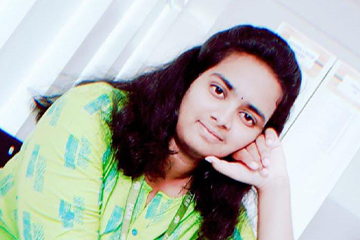 Uha Lakkireddy recently completed her bachelor’s degree in Psychology from SRM University-AP. The tremendous support and motivation from the university have helped her nurture self-confidence and self-satisfaction. Uha noticed how she transformed as an individual from the time of enrolling in the university until the time of graduation. As a psychology student, she was able to grasp several interesting theories which had exciting applications in real life. In-depth details included in the course structure assisted her in the most unexpected but necessary situations. Uha finds it very fascinating that the graduation period has essentially taught her some extremely valuable life lessons. She remembers learning the importance of physical activities in maintaining mental health through Sports Psychology. Uha’s journey as an ardent Clinical Psychology student is taking a huge turn from SRM AP to Greenwich University, UK. She gives all the credit to her faculty and peers, who have always encouraged her to work hard.
Uha Lakkireddy recently completed her bachelor’s degree in Psychology from SRM University-AP. The tremendous support and motivation from the university have helped her nurture self-confidence and self-satisfaction. Uha noticed how she transformed as an individual from the time of enrolling in the university until the time of graduation. As a psychology student, she was able to grasp several interesting theories which had exciting applications in real life. In-depth details included in the course structure assisted her in the most unexpected but necessary situations. Uha finds it very fascinating that the graduation period has essentially taught her some extremely valuable life lessons. She remembers learning the importance of physical activities in maintaining mental health through Sports Psychology. Uha’s journey as an ardent Clinical Psychology student is taking a huge turn from SRM AP to Greenwich University, UK. She gives all the credit to her faculty and peers, who have always encouraged her to work hard.
Continue reading →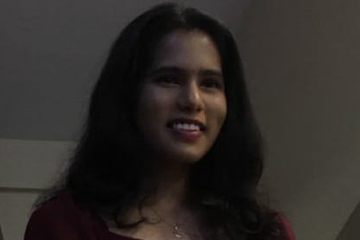 Chandrika Reddy from BSc Psychology at SRM University-AP is excited to continue her studies in Psychology to the next level (Post Graduation) at Adelphi University, New York. She is among the bright students who have secured admission to global universities abroad. Chandrika ecstatically mentioned the exposure she collected from the carefully laid out curriculum and course structure at SRM AP. Her journey as an SRMite was quite eventful. She had excellent professors, classmates, and friends who contributed equally to her growth. She had various opportunities to get engaged in the activities aligned with the coursework and re-establish her hobbies. Being a student of the first graduating batch of BSc Psychology, Chandrika’s achievement is a motivation to all students. She thanked all the professors and peers for their kind support and encouragement throughout this journey.
Chandrika Reddy from BSc Psychology at SRM University-AP is excited to continue her studies in Psychology to the next level (Post Graduation) at Adelphi University, New York. She is among the bright students who have secured admission to global universities abroad. Chandrika ecstatically mentioned the exposure she collected from the carefully laid out curriculum and course structure at SRM AP. Her journey as an SRMite was quite eventful. She had excellent professors, classmates, and friends who contributed equally to her growth. She had various opportunities to get engaged in the activities aligned with the coursework and re-establish her hobbies. Being a student of the first graduating batch of BSc Psychology, Chandrika’s achievement is a motivation to all students. She thanked all the professors and peers for their kind support and encouragement throughout this journey. - Dr Jatis Kumar Dash to join the Editorial Board of Frontiers in Physics journal August 1, 2022
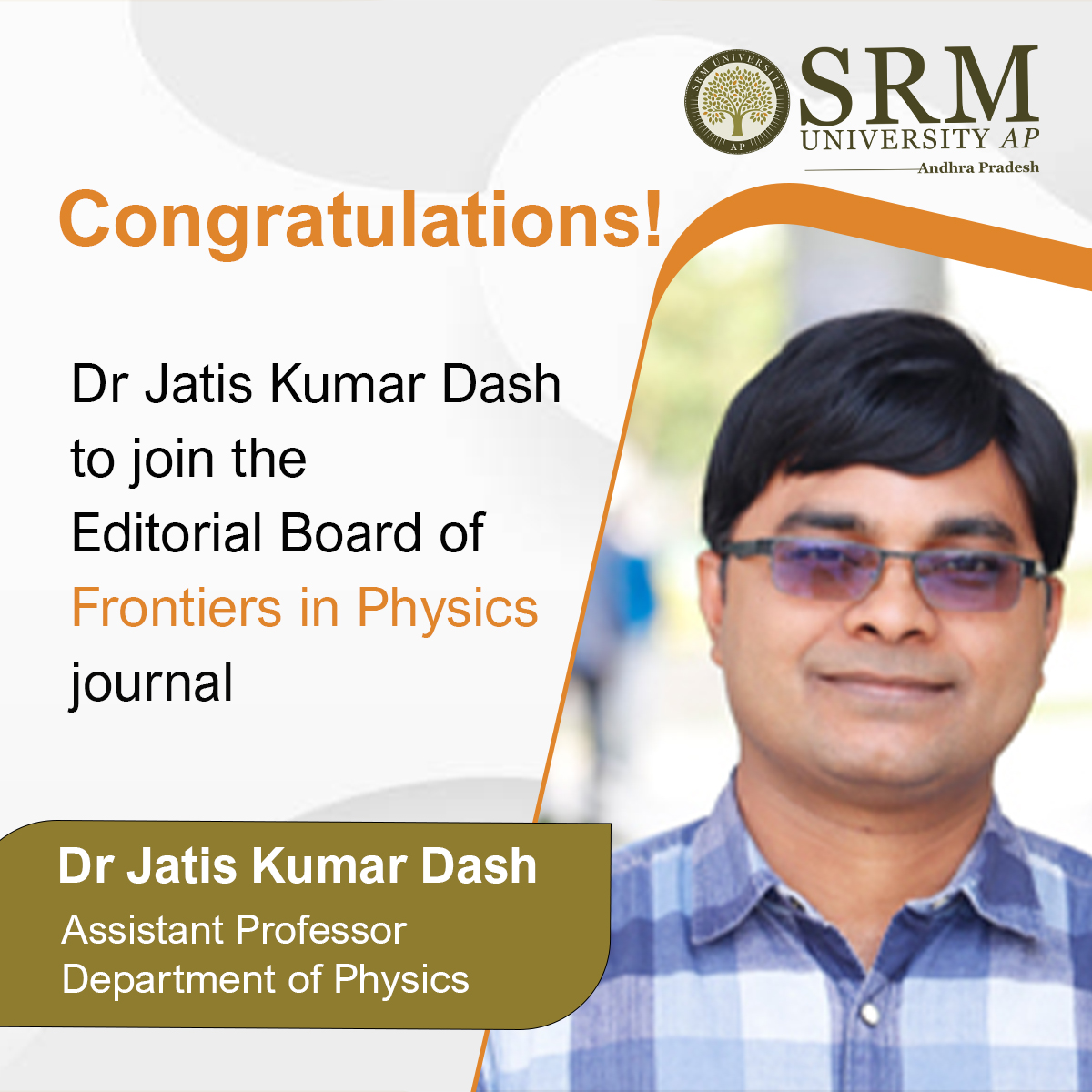 Frontiers in Physics is a peer-reviewed scientific journal. It covers the entire field of Physics ranging from experimental to computational and theoretical physics. Assistant Professor Dr Jatis Kumar Dash from the Department of Physics has been invited to be a part of the Editorial Board of this prestigious journal. The multidisciplinary journal focuses on applied physics and has an impact factor of 3.560.
Frontiers in Physics is a peer-reviewed scientific journal. It covers the entire field of Physics ranging from experimental to computational and theoretical physics. Assistant Professor Dr Jatis Kumar Dash from the Department of Physics has been invited to be a part of the Editorial Board of this prestigious journal. The multidisciplinary journal focuses on applied physics and has an impact factor of 3.560.Dr Jatis Kumar Dash feels honoured to receive the invitation to join the Editorial Board. He finds it satisfying to get involved in scrutinising and reviewing manuscripts that concentrate on materials, experimental and condensed matter of Physics, and related devices. The process of reviewing these manuscripts enriches his knowledge in the subject domain. This helps him widen his research horison and explore novel ideas. The tenure of his role as an editor is not defined but is expected to last for five years.
Continue reading → - Biowaste valorisation for environmental remediation August 1, 2022
Rampant exploitation of resources has indisputably contributed to an enormous rise in solid waste generation. It has been estimated that solid waste generation will shoot up from 1.3 billion tons to 2.2 billion tons in 2025. While 16% of the high-income countries’ population corresponds to 34% of waste being generated, only 5% of the waste generated is attributed to the low-income countries. However, it is a meagre volume of 39% that is collected leaving the rest to rot. This open dumping affects the environment and creates pollution. In addition, improper waste disposal techniques have resulted in emissions of 1.6 billion tons of CO2eq in 2016. Effective waste management is thus a matter of concern in third-world countries.
Assistant Professor Dr Karthik Rajendran and his post-doctoral scholar Dr V S Vigneswaran from the Department of Environmental Science in collaboration with Dr Mukesh Kumar Awasthi from the College of Natural Resources and Environment, Northwest A&F University, PR China, have published their research papers on solid waste management in the journal Bioresource Technology having an Impact Factor of 11.8. This is the second-best journal in the Environmental Engineering category according to SCImago Journal Rank (SJR). The journal aims to disseminate knowledge in the areas of biomass, biological waste treatment, bioresource systems analysis, and technologies associated with conversion or production.

The paper titled “Recovery of value-added products from biowaste: A review” introduces microbial biotechnology for the valorisation of solid wastes. Microbial biotechnology offers several solutions for the utilisation of waste resources. The carbon present in solid and gaseous wastes can be utilised by the microbes as carbon feedstock for their growth. During the growth of microbes on wastes, it produces primary and secondary metabolites, which are of significant use to humankind. The microbes can also be engineered biotechnologically to use waste resources and produce new compounds. Microbial biotechnology, with the use of various genetic engineering tools, can be efficiently explored for the microbes’ modification to utilise different wastes thereby making the environment clean by reducing GHG emissions.
Abstract of the Research
This review provides an update on the state-of-the art technologies for the valorization of solid wastes and its mechanism to generate various bio-products. The organic content of these wastes can be easily utilized by the microbes and produce value-added compounds. Microbial fermentation techniques can be utilized for developing waste biorefinery processes. The utilization of lignocellulosic and plastic wastes for the generation of carbon sources for microbial utilization after pre-processing steps will make the process a multi-product biorefinery. The C1 and C2 gases generated from different industries could also be utilized by various microbes, and this will help to control global warming. The review seeks to expand expertise about the potential application through several perspectives, factors influencing remediation, issues, and prospects.

Food waste in solid forms has been generated throughout the entire food life cycle, from the agricultural production process to the distribution of processed foods and even to their consumption in the market. Considering that approximately 1.3 billion tons of edible food waste is leftover annually, recycling it in the biorefinery will contribute both economically and socially. Another of their publication “Myco-biorefinery approaches for food waste valorization: Present status and future prospects” discusses various types of food waste sources and their evaluation targets. Food waste can be evaluated in fungi-based bioproduction processes for this purpose. In addition, potential biorefinery systems, circular bioeconomy processes, techno-economic studies, and social/ethical aspects of food wastes in the evaluation of valuable products are discussed.
Abstract of the Research
The increase in population and urbanization leads to the generation of a large amount of food waste (FW) and its effective waste management is a major concern. Its putrescible nature and high moisture content are the major limiting factors for cost-effective FW valorization. Bioconversion of FW for the production of value-added products is an eco-friendly and economically viable strategy for addressing these issues. Targeting the production of multiple products will solve these issues to a greater extent. The article provides an overview of the bioconversion of FW to different value-added products.
Continue reading → - Two paper presentations at international research conferences August 1, 2022
Presenting papers at international research conferences helps hone the research questions. Students from the Department of Computer Science and Engineering have attended two international research conferences and presented their papers drafted under the supervision of Assistant Professor V M Manikandan.
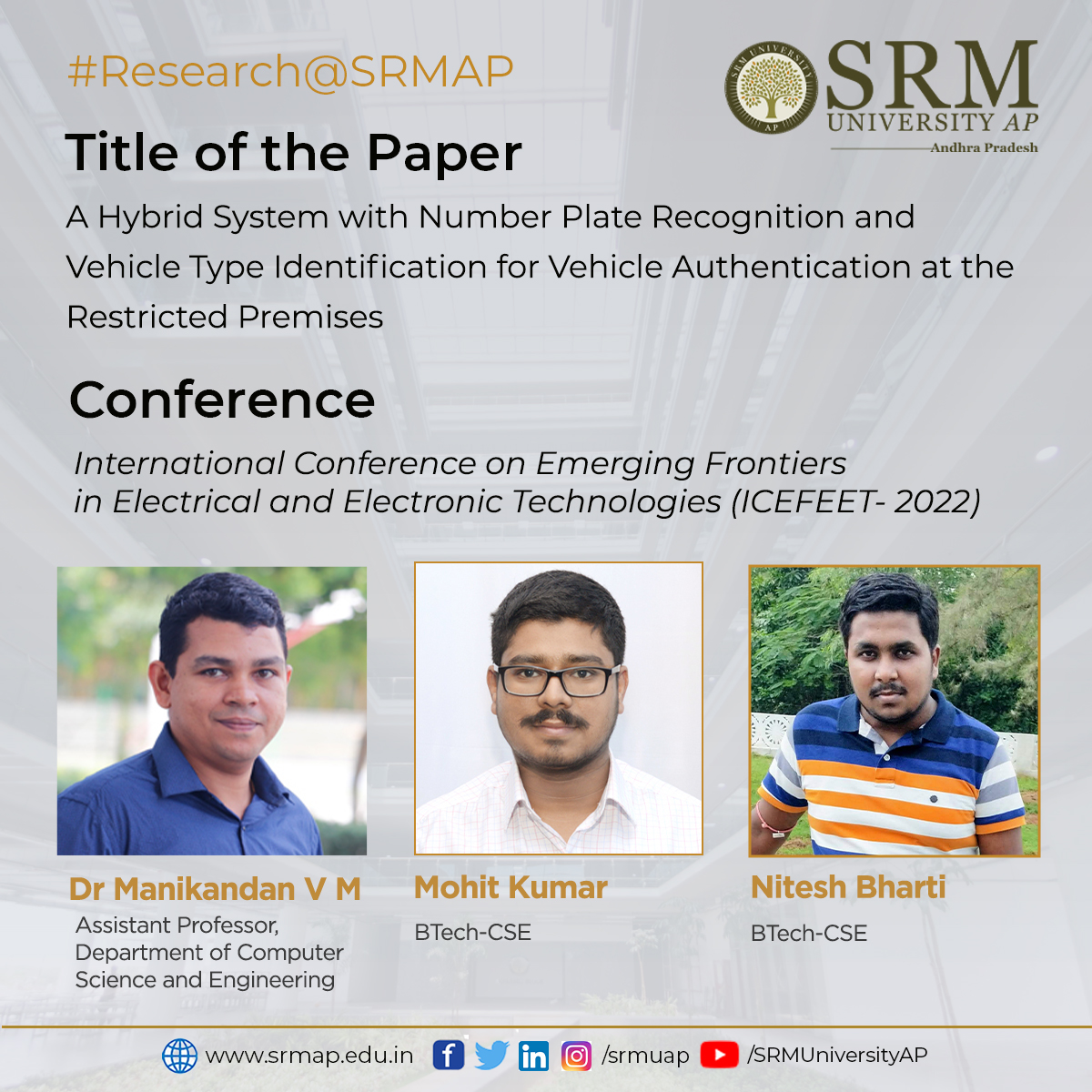 The International Conference on Emerging Frontiers in Electrical and Electronic Technologies (ICEFEET- 2022), organised by NIT Patna, India, was held from June 24 to 25. At the conference, BTech students Nitesh Bharti and Mohit Kumar presented the paper A Hybrid System with Number Plate Recognition and Vehicle Type Identification for Vehicle Authentication at the Restricted Premises. The work was composed under the guidance of Assistant Professor Dr V M Manikandan. The paper will soon be published in IEEE Xplore Digital Library (Scopus indexed). In the future, they plan to integrate the proposed algorithms with proper hardware units to completely automate the authentication of vehicles in restricted areas. The proposed computer vision-based systems can be used in restricted areas to ensure the entry of authenticated vehicles.
The International Conference on Emerging Frontiers in Electrical and Electronic Technologies (ICEFEET- 2022), organised by NIT Patna, India, was held from June 24 to 25. At the conference, BTech students Nitesh Bharti and Mohit Kumar presented the paper A Hybrid System with Number Plate Recognition and Vehicle Type Identification for Vehicle Authentication at the Restricted Premises. The work was composed under the guidance of Assistant Professor Dr V M Manikandan. The paper will soon be published in IEEE Xplore Digital Library (Scopus indexed). In the future, they plan to integrate the proposed algorithms with proper hardware units to completely automate the authentication of vehicles in restricted areas. The proposed computer vision-based systems can be used in restricted areas to ensure the entry of authenticated vehicles.Explanation of the research
Vehicle detection and number plate recognition approaches have been widely studied in recent years due to their wide applications. The research paper proposes a framework to ensure the entry of authorised vehicles in restricted areas such as University campuses, townships, etc., where the researchers are expecting the entry of a set of authorized vehicles. Certainly, unauthorised vehicles might be allowed to enter those areas after proper verification by the concerned people responsible for ensuring security. In the proposed approach, the admin should register all the authorised vehicles in a system with the essential attributes such as vehicle number, type, etc. A surveillance camera placed at the entrance will capture live videos. When a vehicle is in the camera view, the image frames will be passed to an automatic number plate recognition module. The number plate recognition module will identify the same and be matched with the details in the database to authorise the vehicle. This manuscript proposes a real-time and reliable approach for detecting and recognising license plates based on morphology and template matching. To ensure the system’s reliability, a frame selection module will select the image frames with high quality, and even to improve the number plate recognition accuracy, the image will be enhanced using image enhancement techniques such as histogram equalisation. The image enhancement techniques will help to provide better results even though the videos are taken in low lighting conditions. Further, we ensure that the vehicle type matches the number present in the database to prevent unauthorised access using fake number plates. The experimental study is conducted using videos taken under various environmental conditions such as lighting, slope, distance, and angle.
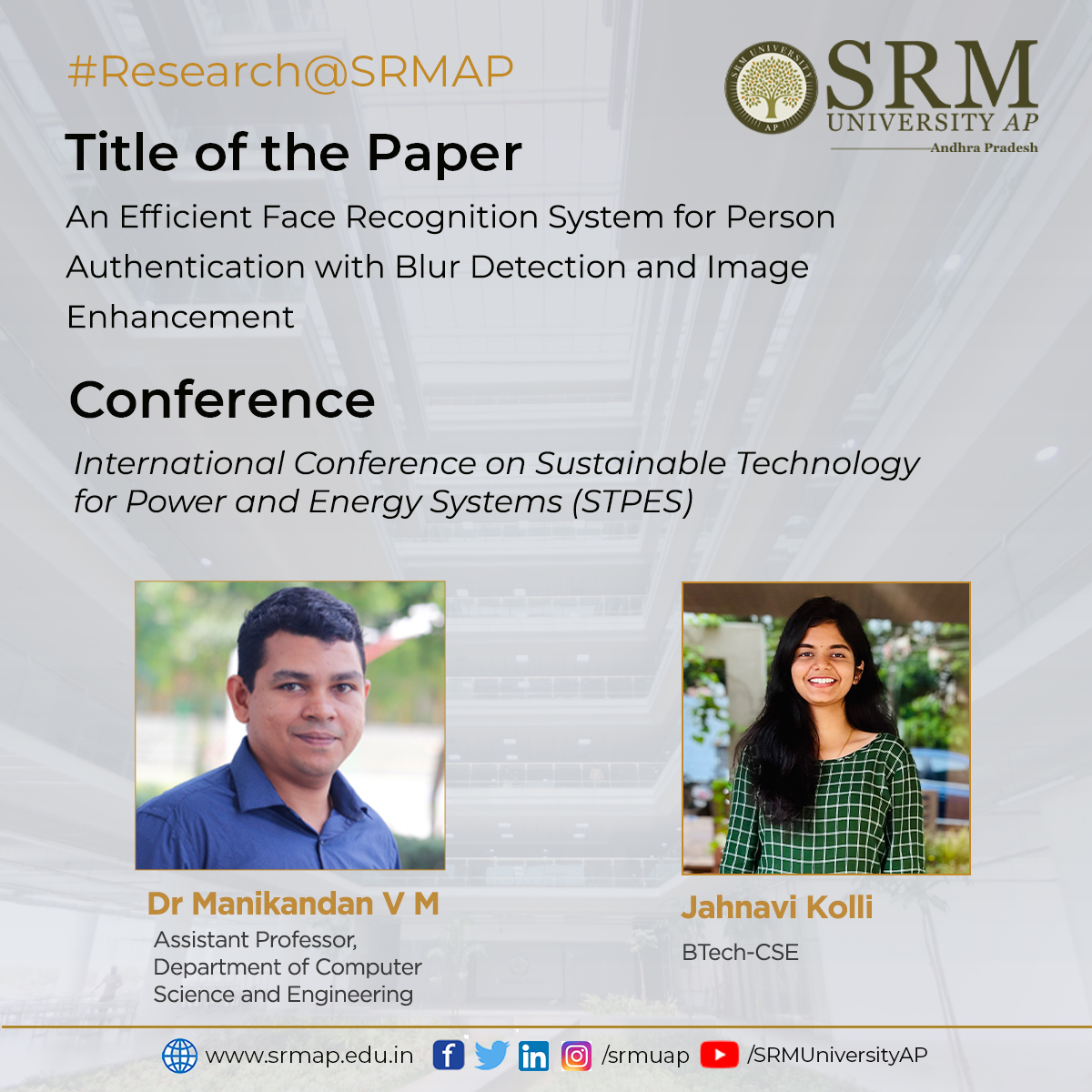 Jahnavi Kolli presented her research paper, An Efficient Face Recognition System for Person Authentication with Blur Detection and Image Enhancement, at the International Conference on Sustainable Technology for Power and Energy Systems (STPES). The conference was organised by NIT Srinagar and IIT Jammu, India, and was held from July 4 to 8, 2022. The research work was monitored by Assistant Professor V M Manikandan and done in collaboration with Professor Yu-Chen Hu, Providence University, Taiwan. The proposed computer face recognition systems can be used to record the attendance of students in class or employees in the office in an easy way. In the future, the researchers plan to improve the face recognition systems, which will perform better when the images are captured using low-resolution cameras or the face regions occluded for some reasons.
Jahnavi Kolli presented her research paper, An Efficient Face Recognition System for Person Authentication with Blur Detection and Image Enhancement, at the International Conference on Sustainable Technology for Power and Energy Systems (STPES). The conference was organised by NIT Srinagar and IIT Jammu, India, and was held from July 4 to 8, 2022. The research work was monitored by Assistant Professor V M Manikandan and done in collaboration with Professor Yu-Chen Hu, Providence University, Taiwan. The proposed computer face recognition systems can be used to record the attendance of students in class or employees in the office in an easy way. In the future, the researchers plan to improve the face recognition systems, which will perform better when the images are captured using low-resolution cameras or the face regions occluded for some reasons.Explanation of the research
The recent advancements in technology widely help to substitute manpower with machines in a better way. Even though machines are increasingly replacing humans in various ways, there are still a few areas where the use of machines still needs to be explored much more efficiently. Facial recognition systems are one such field. Facial recognition systems are used with various motives, such as identification of suspects in public places, authentication of users on restricted premises, etc. In this work, we propose a facial recognition system to facilitate the authentication of students at the university entrance. The same scheme can also be utilised to authenticate the students before entering examination halls. As the strength of the students at universities increases in a more significant way, it becomes strenuous for the security people to record their attendance manually, which frequently results in erroneous data. This paper proposes a facial recognition system that will help to capture the live videos from an area of interest and identify the faces. Further, a face recognition scheme will detect whether the person is authorised or not. Several facial recognition systems are already available in the literature, and this scheme differs from them in many ways. The proposed method selects the frames with less blur for face detection and further face recognition. A blur detection scheme is used in the proposed system to analyse the amount of blur in the image. To overcome the challenges such as low accuracy during face recognition when the images are taken in low lighting conditions, we use a histogram equalization method to enhance the quality. The experimental study shows that the proposed approach works well in real-time.
Continue reading → - From scratch to the published manuscript August 1, 2022
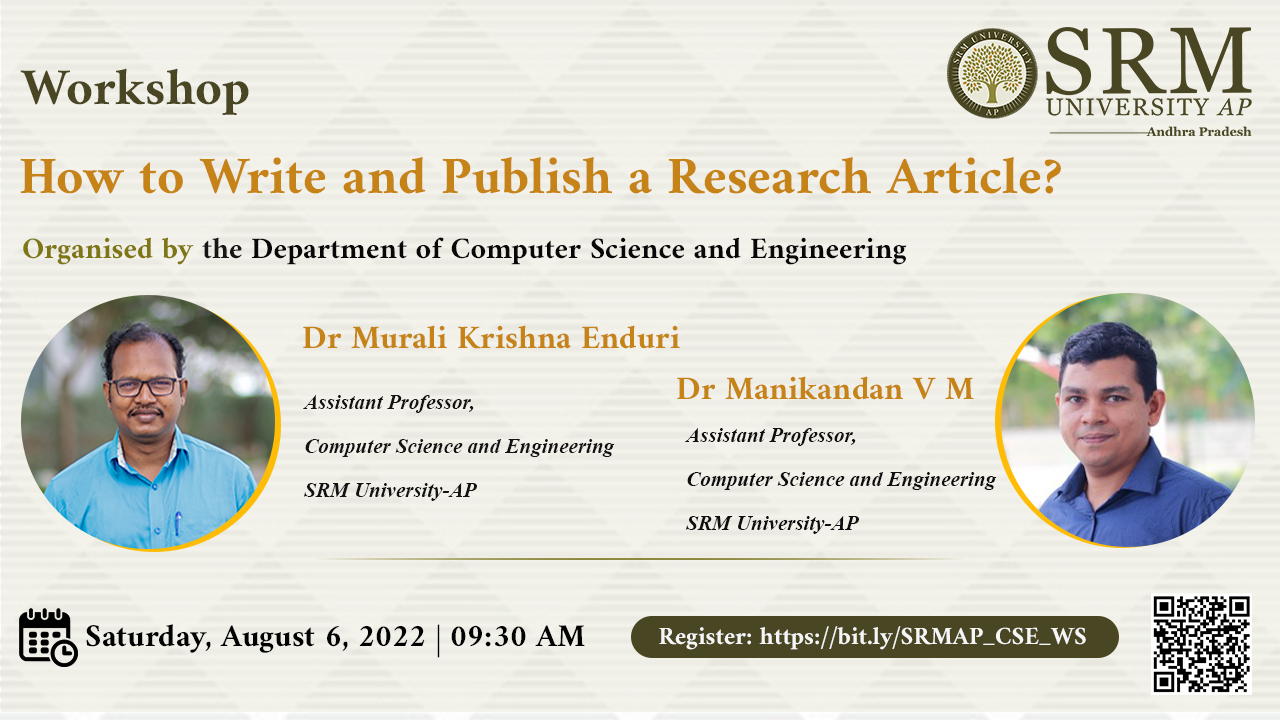 An ideal research process relies on some essential characteristics. One among them is to communicate the research findings. Peer reviewed research journals serve a huge role in this. However, researchers lack an understanding of how to write a publishable research paper. Grasping the basic structure of a scientific paper would help the researcher to decide what should be included in each section. There will be pitfalls in each of these sections but can be avoided if approached strategically. Along with the other components, target journal selection and authorship is also an important aspect of this entire activity.
An ideal research process relies on some essential characteristics. One among them is to communicate the research findings. Peer reviewed research journals serve a huge role in this. However, researchers lack an understanding of how to write a publishable research paper. Grasping the basic structure of a scientific paper would help the researcher to decide what should be included in each section. There will be pitfalls in each of these sections but can be avoided if approached strategically. Along with the other components, target journal selection and authorship is also an important aspect of this entire activity.Successful production of an article for submission to a peer‐reviewed scientific journal requires substantial effort. To ensure this success, The Department of Computer Science and Engineering is planning for a one-day online workshop on How to write and publish a research article.
Date: August 06, 2022
Time: 09.30 am to 1.00 pm
The workshop expects more than four hundred participants. It is open to both students and faculty from UG, PG and PhD programmes. Assistant Professors Dr V Manikandan and Dr Murali Krishna Enduri are coordinating the event. The workshop will give a general idea about topics such as, different options to publish research works, benefits of publishing research articles, steps to write a review paper or research article from scratch, hands-on training with LaTeX to write a research article etc.
Join the workshop to learn the basics of a perfect research article!
Continue reading → - Published the first article under the Indo- Israel bilateral project July 29, 2022
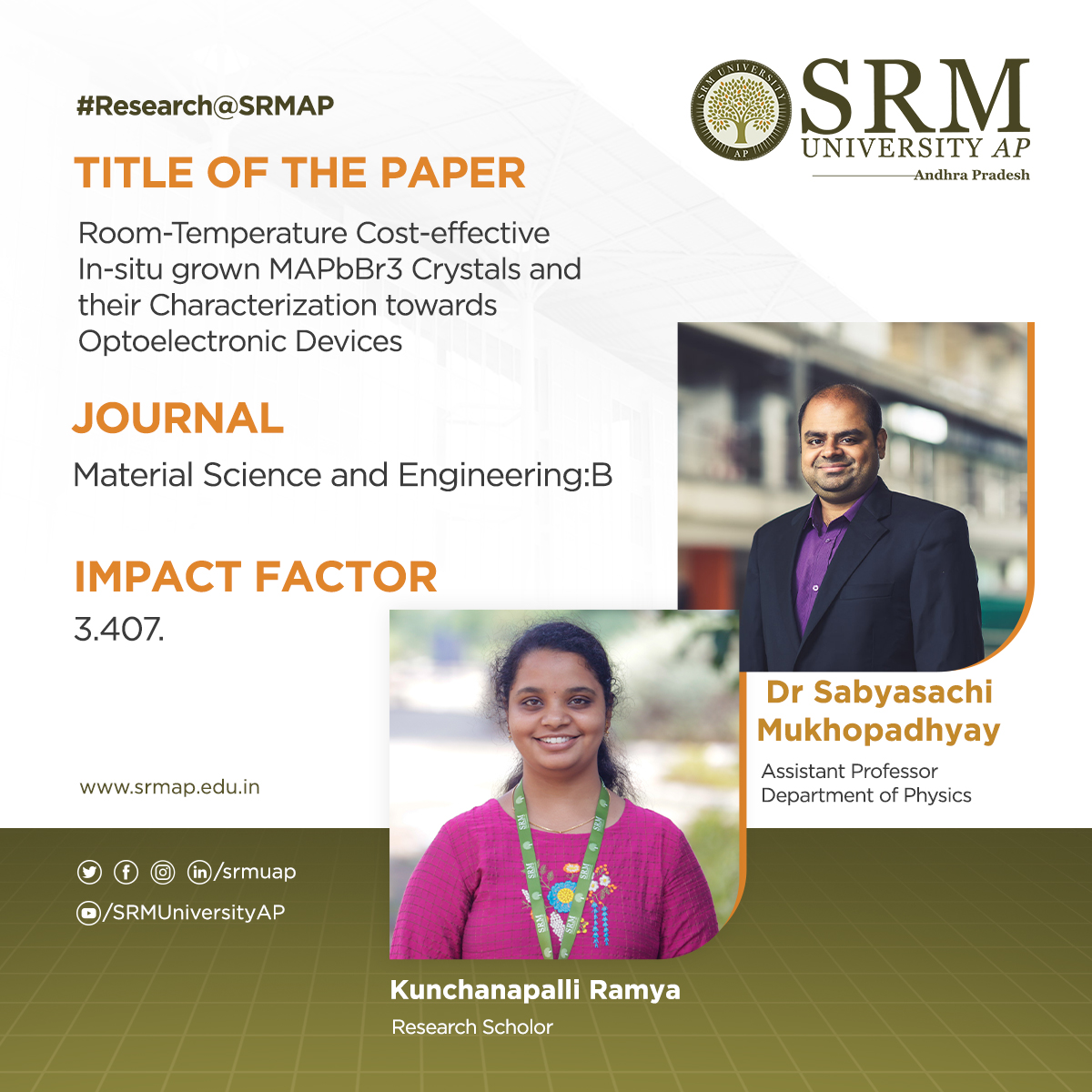 Research at the Department of Physics envisions future studies on the anisotropic properties across various planes of their reported MAPbBr3 crystals and identifying the better plane for efficient electrical contact in device applications. Assistant Professor Dr Sabyasachi Mukhopadhyay and his research scholar Kunchanapalli Ramya recently published the paper Room-Temperature Cost-effective In-situ grown MAPbBr3 Crystals and their Characterization towards Optoelectronic Devices in the journal Material Science and Engineering: B. The paper has an impact factor of 3.407. They have done this work in collaboration with Sr Satyajit, IIT- Bhilai. This is the first article published under the Indo- Israel bilateral project A Halide Perovskite-Based Photoanode for Oxygen Evolution Reaction Using a Molecular Diode in a Hybrid Nanometer Scale.
Research at the Department of Physics envisions future studies on the anisotropic properties across various planes of their reported MAPbBr3 crystals and identifying the better plane for efficient electrical contact in device applications. Assistant Professor Dr Sabyasachi Mukhopadhyay and his research scholar Kunchanapalli Ramya recently published the paper Room-Temperature Cost-effective In-situ grown MAPbBr3 Crystals and their Characterization towards Optoelectronic Devices in the journal Material Science and Engineering: B. The paper has an impact factor of 3.407. They have done this work in collaboration with Sr Satyajit, IIT- Bhilai. This is the first article published under the Indo- Israel bilateral project A Halide Perovskite-Based Photoanode for Oxygen Evolution Reaction Using a Molecular Diode in a Hybrid Nanometer Scale.Abstract
The paper reports the in-situ, room-temperature synthesis of methylammonium lead bromide CH3NH3PbBr3 crystals using N-methyl formamide as a source of methylammonium (MA+) ions during the crystallization process to explore the structural, dielectric, and electronic properties of CH3NH3PbBr3 crystals for optoelectronic applications. Optical absorption and radio-luminescence measurements affirm the direct bandgap nature of the crystals. Impedance spectroscopy measurements with various applied AC voltages within the 20 Hz – 10 MHz frequency range depict the influence of ionic motions on electrical transport across crystal planes. Researchers have extracted electrical transport parameters in CH3NH3PbBr3 crystals from the Nyquist plots, which we found to be distinctly varied wherein two different AC voltage amplitude regimes, broadly for 10 – 50 mV and 100 – 500 mV AC voltage range.
Explanation of the research
The wide approachability of our synthesis method lies in avoiding expensive precursor salts and eliminating the use of toxic solvents. We have obtained the MAPbBr3 crystals with improved thermal, optical, and dielectric properties that are used in optoelectronic devices, mainly in the applications of solar cells and photodetectors.
Continue reading → - Aesthetic labour, Body, and Femininity July 28, 2022
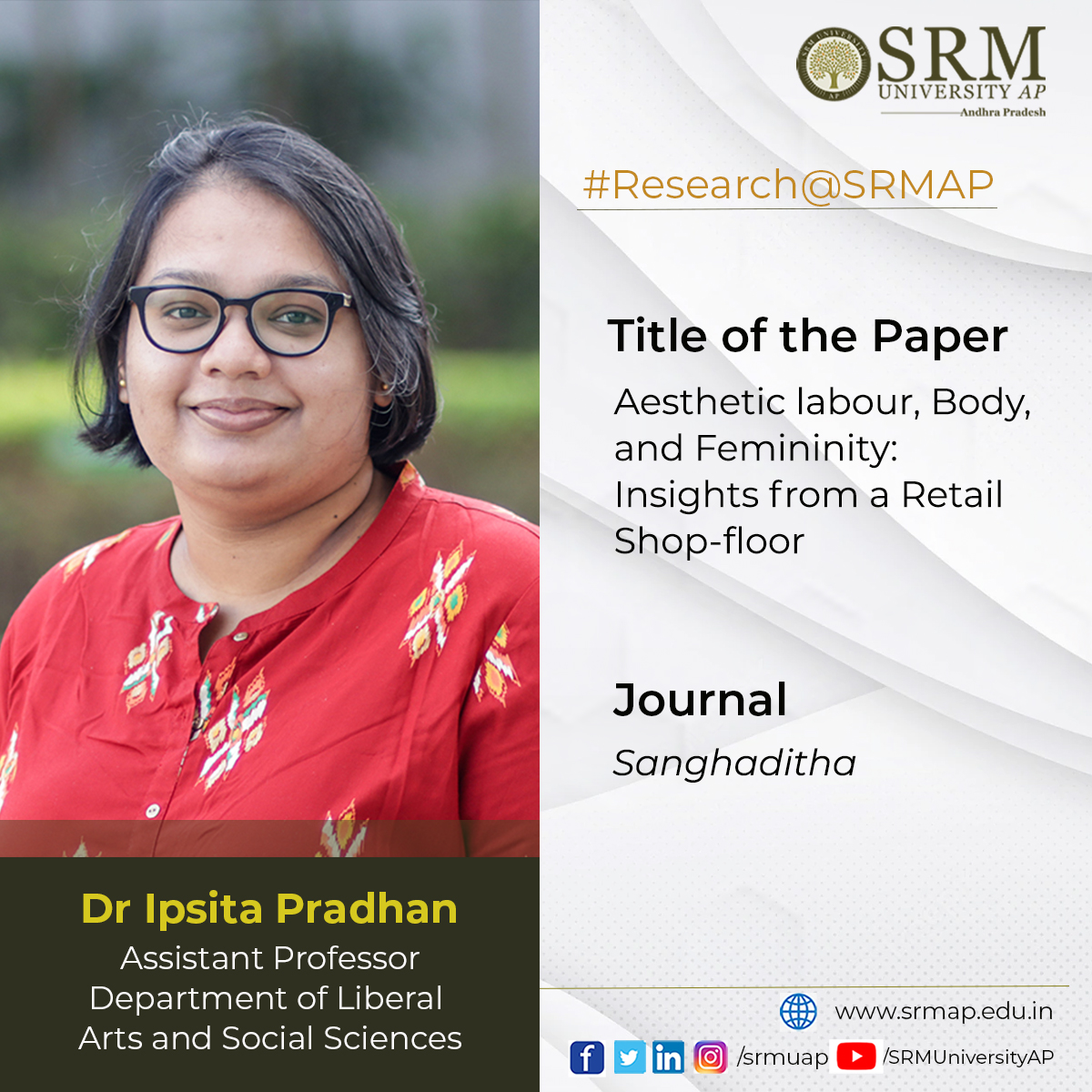 The value of certain looks or appearances is constructed intentionally, and it directly takes part in social stratification. The explanation for this practice can be found in the concept of aesthetic labour. Aesthetic labour implies the practice of screening, managing, and controlling workers on the basis of their physical appearance. When read together with femininity and body, the concept discloses several crucial dimensions. Assistant Professor Dr Ipsita Pradhan, Department of Liberal Arts, published an article titled Aesthetic labour, Body, and Femininity: Insights from a Retail Shop-floor in the journal Sanghaditha. The paper is translated from English to Malayalam by Dr Anu Kuriakose.
The value of certain looks or appearances is constructed intentionally, and it directly takes part in social stratification. The explanation for this practice can be found in the concept of aesthetic labour. Aesthetic labour implies the practice of screening, managing, and controlling workers on the basis of their physical appearance. When read together with femininity and body, the concept discloses several crucial dimensions. Assistant Professor Dr Ipsita Pradhan, Department of Liberal Arts, published an article titled Aesthetic labour, Body, and Femininity: Insights from a Retail Shop-floor in the journal Sanghaditha. The paper is translated from English to Malayalam by Dr Anu Kuriakose.Abstract
The essay discusses the importance of the body in interactive service work. By focusing on women retail shop floor workers, employed in the apparel and cosmetic sections of multi-national brands argues that employment in this sector requires working on one’s body to produce a “presentable” body by grooming so as to fit the larger image that the mall presents. The presence of the mannequin and its dressing is also analysed to understand how it perpetuates stereotypes of the ‘ideal’ body through the apparent function of attracting customers or giving the customers an idea of the products on display, simultaneously perpetuating the male gaze on ‘acceptable’ feminine bodies.
Continue reading → - Watermarking medical images for their secure transmission July 28, 2022

The Department of Computer Science and Engineering is proud to announce that Dr Priyanka, Assistant Professor, and her research Scholar, Ms Kilari Jyothsna Devi have published their patent (application no: 202241033779 A), “A System and a Method for Watermarking Medical Images for the Secure Transmission of Images”. The patent was published on June 17, 2022, by the Indian Patent Office.
In the present technology, medical images and patient information are widely transmitted through a public transmission channel in e-healthcare applications. While sharing medical images or electronic patient records (EPR) through a public network, they can get tampered with or manipulated, leading to wrong diagnosis by the medical consultants. Similarly, one can easily claim false ownership of the medical images. This makes the confidentiality of the patient record at low cost a major concern.
The proposed novel MIW scheme ensures most of the watermarking characteristics such as high imperceptibility, robustness, security with low computational cost, temper detection and recovery in medical image transmission in real-time healthcare applications. In the future, they intend to design digital image watermarking schemes for the secure transmission of images over blockchain and cloud-based applications.
Continue reading → - The genealogy of post-truth and fake news in the Indian context July 28, 2022
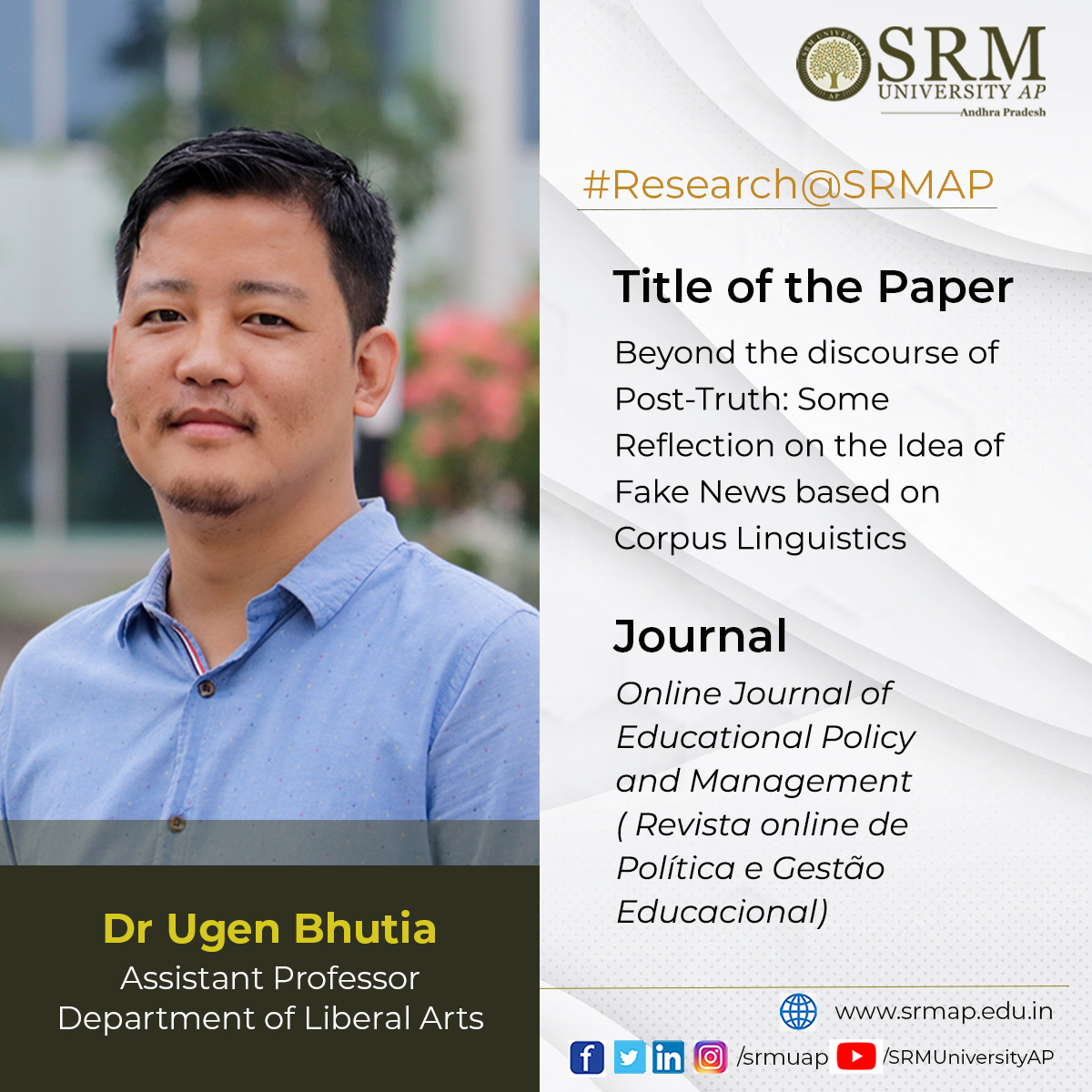 Post-truth represents the replacement of facts with personal beliefs and emotional appeals in order to shape public opinion. The distinction between fake and real news is not about reliable and unreliable sources. It’s about honesty and deception. The media can both inform and deceive people. What makes the news fake is the intention of its author. Discourses are produced by the effects of power within a social order. This power prescribes certain rules and categories that define the criteria for legitimating knowledge and truth within the discursive order. Assistant Professor Dr Ugen Bhutia of the Department of Liberal Arts published an article titled Beyond the discourse of Post-Truth: Some Reflection on the Idea of Fake News based on Corpus Linguistics in the Online Journal of Educational Policy and Management.
Post-truth represents the replacement of facts with personal beliefs and emotional appeals in order to shape public opinion. The distinction between fake and real news is not about reliable and unreliable sources. It’s about honesty and deception. The media can both inform and deceive people. What makes the news fake is the intention of its author. Discourses are produced by the effects of power within a social order. This power prescribes certain rules and categories that define the criteria for legitimating knowledge and truth within the discursive order. Assistant Professor Dr Ugen Bhutia of the Department of Liberal Arts published an article titled Beyond the discourse of Post-Truth: Some Reflection on the Idea of Fake News based on Corpus Linguistics in the Online Journal of Educational Policy and Management.Abstract
The article illustrates how we deceive ourselves by attempting to understand fake news through the notion of a post-truth society. The paper argues that the concepts of fake news and post-truth are not an aberration in the history of media practices and neither of contemporary origins. They are an intricate part of the discursive practices in which media as an institution engages. The article builds on Foucault’s approach to discursive practices and applies a meta-discursive framework to trace the genealogy of post-truth and fake news in an Indian context. The article also critically reflects on some key strategies to contain and counter fake news. For instance, media literacy and linguistic approaches such as corpus linguistics to detect fake news.
Continue reading →

